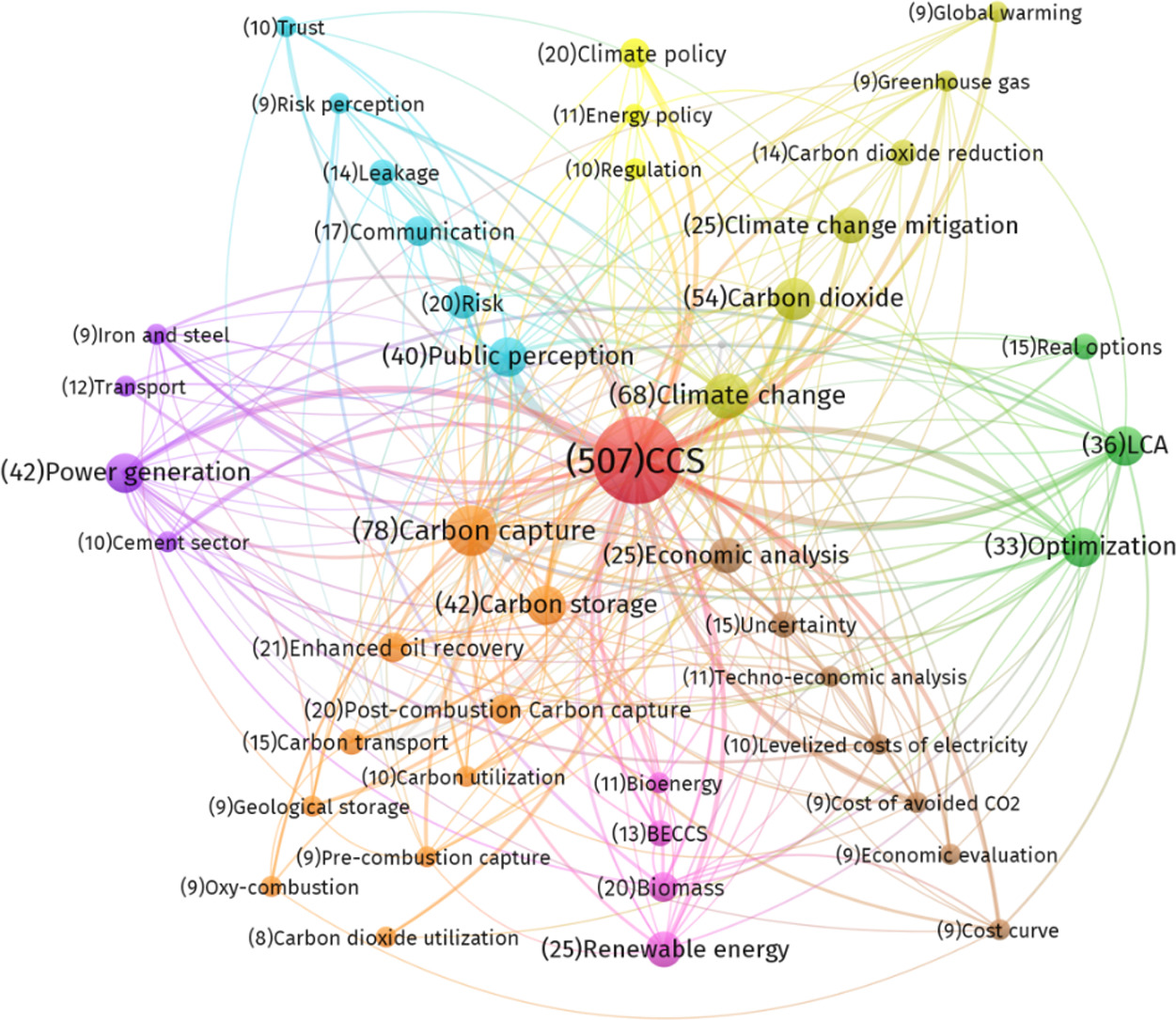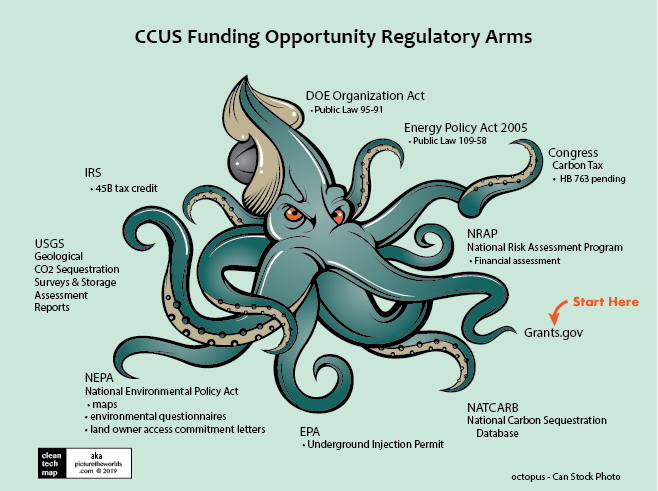CCUS: Cleantech that sucks carbon
Mid-year, an IEA report suggested that failure to develop carbon storage technologies at the scale and pace of its “Clean Technology Scenario”, would result in higher costs and electricity demand (IEA May, 2019 report The Role of CO2 Storage). Most people couldn’t explain what carbon storage is, but having more of it would do a lot to contain carbon dioxide emissions.
This article looks at how climate change is spiking growth in a clean technology called carbon capture and storage (CCS) that lowers CO2 emissions from our use of fossil fuels. Think of our current situation this way: the longer it takes to lower our emissions, the more we will pay. Carbon capture and storage is about taking CO2 out of the atmosphere and permanently re-using or storing it away.
Large scale project proliferation
When I last published a blog post in 2012 about carbon capture, the UK’s Clean Coal Task Group was urging its government for £1 billion to fast track its carbon capture and sequestration competition for power plant trials. Such trials or projects are how clean technology solutions are assessed and deemed ready for large scale commercial deployments.
Back then there were 14 CCS projects, mostly in the US and Canada, with only eight in operation and the rest under construction. None were at coal plants.
Today the International Energy Agency (IEA) lists 23 large-scale projects on its map showing Norway and UAE with two CSS operations each and in Brazil and Australia with one each; China with three, but two are under construction. (See also Clearpath map showing industrial, enhanced oil recovery and geologic storage sites.) But dozens of smaller scale projects in various CCS permutations are showing up in other countries, not only at oil, gas and coal extraction operations and power plants, but also at industrial facilities such as cement, steel, petrochemical plastics, fertilizer and natural gas processing, and food and carbonated beverage makers.
Direct air capture (DAC) is a more recent entrant in the CCS pantheon, but the focus here is on human created CO2 emissions from fossil fuel extraction, industrial processing and power plants. The industrial sector is paramount because it accounts for 25% of global emissions and pollution can be associated and monitored more specifically to facility location and its source, i.e. flue.
Global emissions aren’t coming down
Renewed interest in carbon dioxide removal technologies (CDR), where you actually take CO2 out of the atmosphere, signifies an increasing acceptance of escalating climate change risks that are beginning to cut into everyone’s pockets.
In 2018 carbon dioxide emissions climbed nearly 3 percent to their highest yet according to the Global Climate Project. Two-thirds of the major-carbon emitting countries are not meeting their commitments to the 2015 Paris Agreement. (See Clearing the Air, September 2019, www.energyfuturesinitiative.org)
Consequently, local governments, relief and faith-based organizations, financial and insurance systems, and agriculture-based businesses realized they were left to face mounting strain from extreme weather disasters. Even if you or someone you know hasn't lost a home to wild fire, a crop or herd to drought, or experienced property or vehicle damage from a flooding event, it’s possible to visualize how the effects of climate change are gaining more researchers’ screen time.
The CCS word cloud of research areas published by Elsevier ScienceDirect shows there is mounting attention to the environmental, economic, and social benefits of taking carbon out of the atmosphere.

In September, a UN IPCC special report on Earth’s oceans and coldest areas made up of melting glaciers and shrinking polar ice caps gave us dire warnings of how GHG emissions continue climbing. They still are, which is why carbon capture is lately sparked by a faint sense of desperation in those whose ilk it is to mete out solutions for the ill effects of global warming.
Emissions are bad company: they stay too long and ignore boundaries
A growing contingent of leaders and citizens are alarmed because they’ve come to understand that greenhouse gases stick around for years. Some linger for decades after they are emitted into the atmosphere according to IPCC. It is evident to many already that new technologies need to be explored that will reliably and safely remove GHG from the atmosphere and that such technologies are taken to market sooner, not later.
As a major carbon dioxide and GHG emitter, the fossil fuel industry has no option other than to advance the commercialization of CCUS (carbon capture, utilization and storage / sequestration is the latest nomenclature). They’ve begun calling it a bridge technology that can be used now and in the near future as the development, infrastructure buildup and greater adoption of renewables increases and we figure out how to wean ourselves from fossil fuel.
DOE funding opportunities
In September 2019, the U.S. Department of Energy’s (DOE’s) Office of Fossil Energy (FE) announced the third funding opportunity of $35 million in federal funding for cost-shared research and development projects. Those who qualify must show they can put up additional required amounts for their project.
[Note: $75M was awarded to previously selected CCUS projects under two earlier related funding opportunity announcements (FOAs). See nine project descriptions selected under FOA 2058: Front-End Engineering Design (FEED) Studies for Carbon Capture Systems on Coal and Natural Gas Power Plants (2 are coal-fired) and four project descriptions selected under FOA 2000: Regional Initiative to Accelerate CCUS Deployment.]
What’s confounding is that seven years after the UK’s Clean Coal Task Group asked for £1 billion investment in CCS projects, in 2019 the US Department of Energy’s announcement offers $110 million.
CCUS could lower remaining US 241 coal plants’ emissions
The announcement claims, absurdly, that the FOAs further the Administration’s “commitment to strengthening coal while protecting the environment.” Such language could not be further from the truth in light of the fact that 50 plants shut down since President Trump took office in 2017. Overall, 40% or 289 coal plants in the US have closed, in part because more solar and wind powered electricity became available at prices lower than from coal-fired power plants, which made it hard for coal plants to compete.
The abundance of natural gas from fracking also dented the coal fueled electricity market, not only because the combustion of coal emits twice as much CO2 as burning natural gas, but also because the price of natural gas was kept artificially low, albeit at the expense of energy sector investors over the last year or two. There's also the disincentive for gas- and coal-fired power plants that adding on or building new plants with CCUS systems, raises their costs and puts upward pressure on energy prices. To be fair, the honest price of fossil fuel derived energy is a topic for another blog post.
Capturing CO2 for use in EOR – Enhanced Oil Recovery
The US Department of Energy (DOE) and the oil and gas industries were early proponents in building interest in developing CCUS technologies (Science of The Total Environment, Volume 687, 15 October 2019, Pages 687-701). In part that is because as far back the late 1960s and early 1970s leading up to the 1973 OPEC Oil Embargo, rising oil prices forced the industry to figure out that when CO2 is injected into oil fields it allows more oil to be pumped out in a process known as enhanced oil recovery, or EOR.
Now after we've learned of the petroleum industry’s spending decades and dollars obscuring the connection between emissions and global warming, at first its renewed look at how to expand CCUS technologies might seem to signal a sudden change of heart. More likely, a combination of government incentives, including tax credits and funding opportunities, gave rise to research and development resulting in innovations that make retrofitting, adding on or building CCUS facilities more economically attractive now that climate change is nipping at profits.
Capture CO2 we produce and Re-use it
When CO2 is harvested from natural sources instead of recaptured from industrial processes (or other anthropomorphic source) before it reaches the atmosphere, it might run through hundreds of miles of pipelines which figures into production lifecycle efficiency. Currently oil and gas companies obtain between 60-70 percent or about 2.3 billion cubic feet a day of the CO2 they need for EOR by piping it from natural occurring sites along the Gulf Coast according to Energywire reporter Mike Lee. (Big Oil looks to CCS, but will it really help the climate?, E&E News, June 19, 2019.) The real problem climate-wise of using natural sources is that there is no reduction in emissions, which is the CCUS end goal.
One future scenario is that industries such as natural gas processing plants, petrochem (plastic) refineries, power plants, cement and steel would capture their CO2 emissions and share the “utilization” (the “U” in CCUS) of these CO2 emissions with nearby industrial operations such O&G drilling operations, carbonated beverage and food makers in CCUS hubs. Such hubs could offer investment opportunities. Keep in mind that the industrial sector which includes all of the above (including O&G extraction) account for roughly one quarter of global CO2 emissions.
An alternate decarbonization path for an EOR operation, would mean capturing the CO2 that that doesn’t remain below the ground and escapes to the surface. According to IEA, between 300 kg CO2 and 600 kg CO2 is injected in EOR processes per barrel of oil produced in the United States. Any CO2 that is injected back into the oilfield would form a closed loop, and potentially result in avoided emissions, which IEA claims results in permanent storage.
If you can’t re-use it, store it - forever
The “S” in CCUS refers to permanent storage or sequestration of carbon dioxide so that it is removed from the atmosphere for the foreseeable future and, typically, is injected deep underground in saline reservoirs, although other storage methods are being researched. Operators have to demonstrate the permanency of CO2 storage by identifying sites with suitable geology, ensuring that the “plug” traps CO2; introduce monitoring and field surveillance to detect potential leakage. In particular, DOE funding applicants need to complete a detailed site characterization of a commercial-scale CO2 storage site (50 million metric tons of captured CO2 within a 30 year period); apply and obtain an underground injection control class VI permit to construct an injection well; complete a CO2 capture assessment; and perform all work required to obtain a National Environmental Policy Act determination for the site. More details about how a project is selected can be found in the FOA requirements.

In April 2019, over a hundred members of the 116th Congress signed a letter to the Chairman of the Senate Ways and Means Committee, U.S. Representative Richard Neal, pointing out that “the U.S. tax system has over forty provisions that provide billions in subsidies which are overly complex and provide different subsidies to similar technologies, many with no discernible rational. It continues to provide permanent subsidies to polluting industries while leaving clean, renewable energy companies in the lurch.”
To stimulate the level of investments that can drive continuous cleantech innovations, such as those in carbon dioxide storage over the last decade, legislators would need to review existing tax provisions passed 10 years ago. To keep up with changes in cleantech, the letter urges Congress to streamline regulations and make them simpler. If not, the U.S. Goverment's National Climate Assessment, under the current administration, estimates that climate change caused by rising emissions could knock off 10 percent of the gross national product in the next 80 years.
Bioenergy with CCS
Over the next forty years, CCUS could turn out to be a lower-cost emissions reduction option in the fuel transportation sector. In the IEA Clean Technology Scenario CCUS could contribute up to half of the emissions reductions achieved. This scenario suggests that by encouraging the development of carbon capture and storage technology using bioenergy instead of fossil fuel, solar or wind, that transportation fuels could become net carbon negative by 2060 (BECCS). The important point in this post, however, is that CCUS technologies for the industrial sector are ready to be deployed now.
Government incentives
On the upside, CCUS projects are eligible for expanded 45Q tax credits. Since 2018 when Congress passed the Furthering Carbon Capture, Utilization, Technology, Underground Storage and Reduced Emissions Act (S. 1535) as part of the Bipartisan Budget Act, the Internal Revenue Code was amended to extend tax credit for sequestration and spur investment in next-generation CCUS technologies. Companies using EOR will be able to claim $35 per ton of CO2 captured. If instead of using EOR, captured CO2 is injected into underground storage fields, the tax credit increases to $50 per ton. Direct Air capture projects are also be eligible if a project is begun before 2024.
Larger step-change in funding to accelerate energy innovation such as CCUS is needed to reduce emissions faster and at larger scale. Some financial incentives that make sense to assess include expanding the scope of DOE and other federal loan and loan guarantee programs. Expanding eligibility and introducing greater flexibility for credit such as co-lending and secondary credit support to state and local financial assistance programs like Green Banks to stimulate public private partnerships to reach decarbonization. Last, but not least, incentives and tax credits need to be aimed at innovative and entrepreneurial outcomes including smaller projects rather than rewarding large GHG emitters that prolong dependence on fossil fuel practices.




